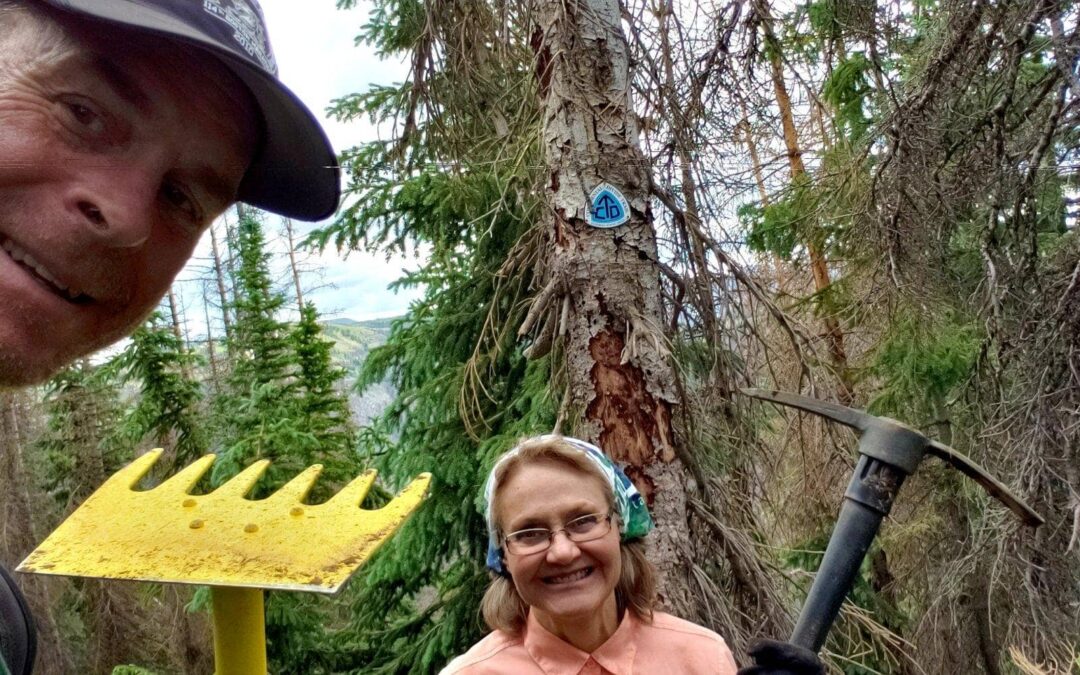The Continental Divide Trail depends on the hard work and dedication of volunteers and trail adopters. This month, we shine a spotlight on Trail Adopters Jeff and Hallie Owsley!
Q: How did you get started in trail work?
A: Hallie and I both grew up in hiking families, she in southern Arizona and I in southern Colorado. We carried that love of trails into our 30+ years of marriage, before kids, along with them, and now as empty nesters. Participating in a Volunteers for Outdoor Colorado trail build was a huge aha moment. It opened a world of learning how to create a lifetime-lasting trail, how to breath new life into old ones, and provide regular grooming to keep them beautiful. It was a perfect expression of our love of them.
The idea of trail adoption, especially on the premier trail in our region, the CDT, was one of the quickest mutual decisions of our marriage. Seeing a section open for adoption that starts at our iconic family-favorite Blue Lake, near our generational family cabin in the Conejos Canyon, felt like being able to get extremely prized season tickets to the Denver Broncos on the 50 yard line. We chose to adopt the feeder trails leading to both sides of our 6 mile CDT section, making the total loop 19 miles.
What do you enjoy most about being a CDTC Adopter?
We enjoy helping enhance the joy of experiencing the CDT for others. It’s an honor to be fellow stewards serving together with many others who have adopted section after section all along this important national treasure.
Tell us a a little bit about yourselves!
Hallie is a retired middle school and high school science teacher and Jeff works in affordable housing and community development. Travel has been a big part of our lives. While single, Hallie taught school in Ivory Coast, West Africa and Jeff lived in Austria. In our early married life, we worked in humanitarian aid in Albania and Macedonia for five years. Besides spending time outdoors in all seasons, we enjoy reading books aloud to each other, working out and running. Jeff has been into running in an especially big way as an ultra marathoner and also as a race director. One race he created is the Rio Frio 5k on Ice, a race run entirely on the frozen Rio Grande, as the river meanders near their hometown Alamosa, Colorado and freezes most years with thick ice covered by snow that provides traction.
What was your favorite part of volunteering on one of our projects?
Volunteering on an organized project is the best way to learn about trail maintenance. It’s a chance to learn from highly experienced leaders and work alongside others who are passionate about trail stewardship.
Any advice for someone who’s never done trail work before?
An important role of trail adopters is to survey the section and report findings to the governing land agency. Have a pocket sized notepad handy to take notes. Some sort of GPS or mileage tracking device allows you to accurately record locations and taking photos gives even more detail. Note details such as numbers of downed trees and their approximate diameter and how many feet of trail is affected by water damage each time you notice it. It is especially important to report or fix areas that could be dangerous to users. Help users stay on trail by clearly directing away from side trails. On their first survey of their section, Jeff followed such a trail that seemed like the main (and only) trail that led to a separate area, where he searched and searched to pick up the trail again, only to realize upon backtracking that the main trail had become overgrown with grass in a small meadow. We now make sure no one else goes astray by keeping the tread very clear through the meadow and blocking the side trail that led to an overlook area with branches.
What’s your must-have tools or gear when you’re working on your adopted segment?
We find we can do most any tread work needed with a McLeod and a 2.5 lb pick mattock. One tip is to wear pants or shorts with cargo pockets to keep a notebook and phone for photo taking in one pocket, and a folding saw and extendable pruning shears in the othet. That way, you can quickly take care of simple corridor clearing without taking your backpack off. Another efficiency trick is to increase your ‘foot wedge’ skills for clearing loose rocks and sticks from the trail, rather than bending over all the time to pick them up. Besides always carrying essential survival gear and supplies, never be without a water purification system. You may think you’re carrying enough drinking water, but little projects here and there add up you don’t want to get caught in the high country without drinking water. We always carry a pocket-sized book or plastic flash cards on a carabiner with trail maintenance methods and specifications. Another tip is to continually keep learning new skills by taking advantage of training opportunities. This past year we both got certified as cross cut sawyers for clearing trees in the wilderness.
Thanks again to Jeff and Hallie! Want to get involved? Check out our trail work volunteer opportunities here, no prior experience required!

